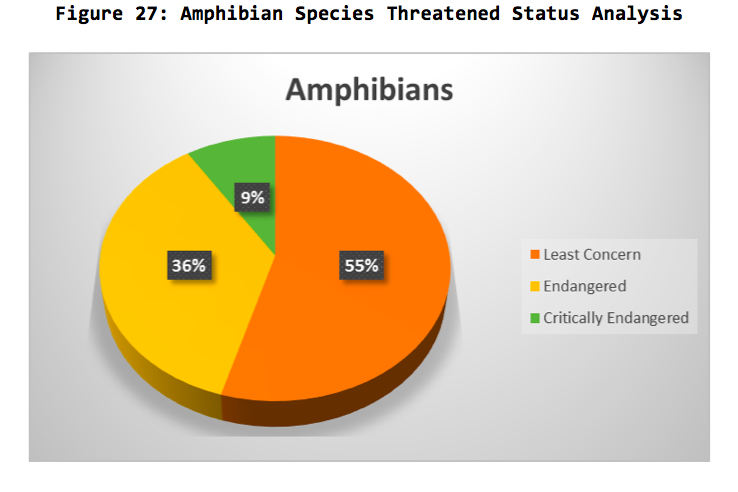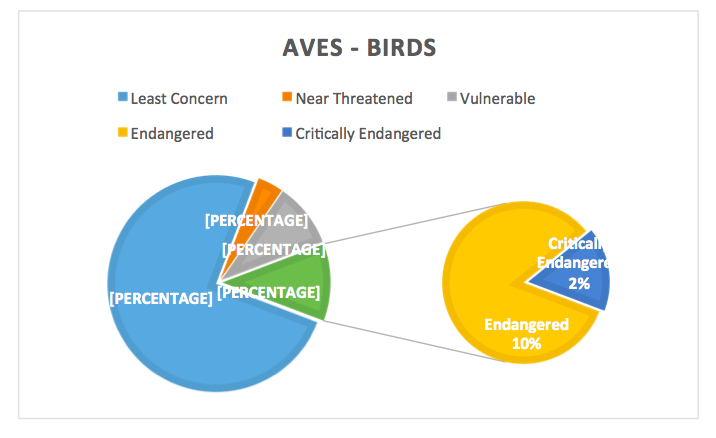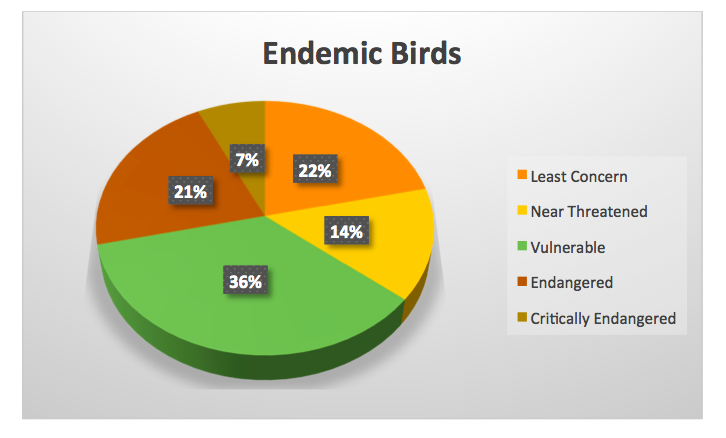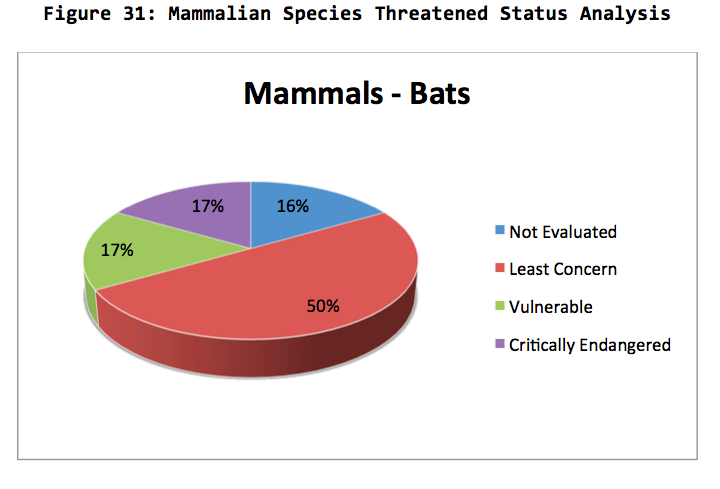Biodiversity Threats
Seychelles’ fourth national report to the CBD recognized that national biodiversity could be described through the lens of three Convention Programmes of work namely: Forest, Inland waters and Marine and coastal biodiversity. The main threats to those ecosystems types and their component habitat categories remain unchanged in the subsequent three years. (GoS 2014, GoS 2011).
The overriding threat to forest biodiversity is the ongoing incursion of Invasive Alien Species. The vast majority of forest cover in Seychelles is secondary and already highly invaded by introduced species which often form the primary canopy species. Status and trends of IAS invasion of forest ecosystems in key biodiversity areas and refuges are not well understood. The current full-size GEF project on Biosecurity has been focusing on the strengthening of controls to prevent introductions of new IAS, with a new focus on eradication and control of IAS to follow in the next CBD reporting period. A secondary concern is that of forest fire in particular with regard to the threat it poses to dry endemic palm woodland areas.
The extraordinary geographic and evolutionary isolation of the inland waters of Seychelles’ granitic islands, surrounded in all directions by a 1000 miles of ocean and separated from continental landmasses for 70 million years, makes them of particular biodiversity interest. Lowland wetlands are probably the most threatened habitat type in Seychelles due to the limited land area and the consequent development driven “coastal squeeze” making habitat loss through change in land use the primary threat and ongoing driver of biodiversity loss in this habitat type. It is estimated that more 90% of the lowland wetland habitats of the central archipelago have been lost in the last 200 years (Gerlach 2002).
This ecosystem type is highly diverse and was divided into eight habitat categories in the 4th National Report (GoS 2014). This diversity in turn means that the categories often face different threats. However the main threat, in terms of biodiversity conservation and socioeconomic well-being, is unsustainable use of fishery resources with secondary factors for coastal habitats of habitat loss, through change in land use, and pollution.
Coastal development has greatly reduced natural vegetation cover impacting upon key habitats such as lowland woodlands and beach crest vegetation – including impacting severely upon nesting habitat for endangered turtle species. There is also strong anecdotal evidence to suggest that the land reclamation program on the east coast of Mahé has destroyed critical habitat causing the collapse of two fisheries: the White-streaked grouper (Epinephelus ongus) and the Marbled parrot fish (Leptoscarus vaigiensis). It has likely also had significant impact upon the key shark nursery area for several species, but this is hard to quantify as no pre-reclamation baseline was established.
Other challenges to biodiversity are climate change, knowledge and data management, and mainstreaming of environmental economics.
The complexity of ecosystems and the diverse nature of the stresses upon them often makes it difficult to isolate the specific impacts of climate change. However, there is no question that climate change contributes to existing stress on biodiversity and worsens biodiversity degradation.
For Forest biodiversity, change in ambient temperature and rainfall patterns can affect habitat structure enhancing IAS action, or make species more stressed and prone to disease, which may have been a factor in the spread of Takamaka wilt disease (Vielle 1999). The correlation between weather patterns and forest fire occurrence is of course well understood.
For marine and coastal biodiversity, climate change is a key driver of biodiversity loss the prime example in Seychelles being the extreme coral bleaching event experienced in 1998 that caused 80-90% live coral loss on the Seychelles plateau. This has ongoing ramifications for fish populations and related fisheries (Graham 2007). Water temperature likewise affects the movement and distribution of pelagic stocks that have vital economic importance. Water temperature may have other physiological affects upon biodiversity affecting breeding cycles, seasonality and productivity – for example the temperature of incubating turtles’ nests is known to influence the sex ratio of offspring.
Climate change fuels more severe weather events such as storm surges and changes prevailing weather patterns effecting the normal seasonal cycles of erosion and accretion both of which can have significant impact upon the physical and biotic components of the coastal environment.
Limited knowledge and understanding of biodiversity, its status and trends, species ecology and biology, functions and values constitutes a critical threat to conservation and sustainable use as it impedes informed decision- making. For example, lack of species based data in the management of fisheries has been a critical factor limiting the ability to develop effective plans for various components of the artisanal fishery.
Lack of knowledge also undermines the efficacy of environmental impact assessment measures for example in protecting critical habitats from development pressures e.g. the EIA process for the phase 3 east coast reclamation made no reference to the potential loss of key habitats for certain fisheries – the subsequent collapse of fisheries for the White-streaked grouper (Epinephelus ongus) and the Marbled parrot fish (Leptoscarus vaigiensis) have been directly connected with habitat lost to the reclamation.
There is a significant lack of national capacity in this domain with no qualified practitioners in the country at this time. This shortfall has been noted in previous strategic documents (e.g. first NBSAP and EMPS) but has not been successfully addressed. There is a real concern that the true value of biodiversity is not incorporated into decision making processes and specifically development planning whether it be pertaining to drainage/reclamation of lowland wetlands or in specific species-based cases such as the hotel developments that impacted key Sheath-tailed bat (Coleura seychellensis) and Hawksbill turtle (Eretmochelys imbricata) habitats in recent years.
Freshwater Fish
15 species considered indigenous have been recorded to date. 5 species, including the 2 endemic species, have not thus far been evaluated for IUCN status whilst the other 10 species are classified as Least Concern.
Amphibians
11 indigenous species of amphibian, all endemic, have been recorded to date in Seychelles: 5 frogs and 6 caecilians. 6 species are classified as Least Concern, 4 Endangered and 1 Critically endangered. This means that 45% of Seychelles indigenous amphibians are considered threatened.
Reptiles
Seychelles has 23 recognised species of indigenous terrestrial reptile – 2 species of snake, 19 species of lizard, 1 species of Giant tortoise and 1 terrapin. There is some debate on these figures, in particular due to the status of some lizard taxa currently recognised as endemic sub-species. Previous claims about multiple species of endemic giant tortoise (Gerlach & Canning 1998) have not been supported by genetic analyses (Austin et al 2003, Palkovacs et al 2003) and have been strongly questioned by peers (Frazier 2006, Shah 2003) as such only one species is recognised here. One terrapin, Pelusios subniger, previously considered an endemic sub-species has recently been shown to be an introduced species whilst the other Pelusios castanoides may also later prove to be an introduction. Of the 23 species: 3 have not been evaluated, 9 are classified as Least Concern, 1 as Near Threatened and 10 or 44% as Threatened (3 Vulnerable, 6 Endangered and 1, P. castanoides sub-species, as Critically Endangered).
Figure 28: Reptilian Species Threatened Status Analysis
Birds
52 species of bird are considered indigenous to Seychelles – 18 seabirds and 47 land birds – 14 species of which are considered endemic.( Including recognition of Coracopsis barklyi (Reuleaux et al 2013) and Dryolimnas aldabranus (Wanless 2003, Wanless & Hockey 2008) as full species. Several other species are considered to be represented by endemic sub-species in Seychelles.) 13 resident species are introduced. Another 25 species are classified as annual migrants whilst approximately 150 additional species have been recorded as vagrants. Of the 52 indigenous species 39 are classified as Least Concern, 2 as Near Threatened and 11 species, or 21% of bird species, as threatened (including 5 classified as Vulnerable, 5 as Endangered and 1 as Critically Endangered).
Consideration of the 14 endemic species gives another perspective. 3 species are considered of Least Concern, 2 Near Threatened and 9 species, or 64% of the endemic species, are considered Threatened – 5 species Vulnerable, 3 species Endangered and 1 species Critically Endangered (see Fig. 30).
Figure 30: Endemic Bird Species Threatened Status Analysis
These rather gloomy figures however do not reflect the overall improvement in the status of endemic bird species over the last 20 years, where a combination of invasive species eradications, ecosystem rehabilitation and species (re)introductions have seen several species’ populations increase and the threatened status of some downgraded (GoS 2011) . The Critically Endangered Seychelles Paradise Flycatcher (Terpsiphone corvina) was reassessed in 2012 following its introduction to Denis island in 2008 and provided both populations are self-sustaining in 2017 it also will be downgraded to Endangered.
Mammals
There are 6 species of indigenous land mammals in Seychelles and they are all bats. 4 of the species are endemic including the recently discovered Triaenops pauliani (Goodman & Ranivo 2008). 3 of the species are classified as Least Concern, 2 are classified as Threatened – 1 Vulnerable and 1 Critically Endangered. The newly discovered T. pauliani has not yet been evaluated but will likely be considered threatened due to its very restricted range on an island of Aldabra atoll. The Seychelles Sheath-tailed bat (Coleura seychellensis) is Critically Endangered numbering less than 100 and apparently extirpated now on all but the islands of Mahé and Silhouette. It is one of the world’s rarest mammals with the main cause of its demise being degradation of its coastal habitats – including a roosting site degraded by a recent tourism development (EDGE 2014).
Austin, J.J. et al (2003). Was there a second adpative radiaton of giant tortoises in the Indian Ocean? Using mitochondrial DNA to investigate speciation and biogeography of Aldabrachelys (Reptilia, Testudinidae). Mol Ecol. 2003 Jun; 12(6): 1415-24.
EDGE (2014). Seychelles Sheath-tailed Bat (Coleura seychellensis). Evolutionarily Distinct & Globally Endangered. Zoological Society of London.
Frazier, J. (2006). Book review: Giant tortoises of the Indian Ocean. The genus Dipsochelys
Gerlach, J. & Canning,L. (1998). Taxonomy of Indian Ocean Giant tortoises (Dipsochelys). Chelonian Conservation and Biology 3:3-19
Goodman, S.M. & Ranivo, J. (2008). A new species of Triaenops (Mammalia, Chiroptera, Hipposideridae) from Aldabra Atoll, Picard Island (Seychelles). Zoosystema Vol. 30 pp. 681-693, 2008.
Government of Seychelles (2011). Fourth National Report to the United Nations Convention on Biological Diversity. Environment Department, P.O. Box 445, Botanical Gardens, Mont Fleuri, Victoria, Republic of Seychelles. Report prepared by John Nevill.
Government of Seychelles (2014). Fifth National Report to the United Nations Convention on Biological Diversity. Ministry of Environment and Energy, P.O. Box 445, Botanical Gardens, Mont Fleuri, Victoria, Republic of Seychelles. Report prepared by John Nevill.
Graham, N.A.J. et al (2007). Lag Effects in the Impacts of Mass Coral Bleaching on Coral Reef Fish, Fisheries and Ecosystems. Conservation Biology Vol: 21, Issue 5, pages 1291-1300, October 2007
Palkovacs, E.P. et al (2003). Are the native giant tortoises from the Seychelles really extinct? A genetic perspective based on mtDNA and microsatellite data. Molecular Eclogy (2003) 12, 1403-1413. Doi: 10.1046/j.1365-294X.2003.01834.x
Shah, N.J. (2003). Leave George be. New Scient. 178(2401):25
Vielle M. (1999). Vascular wilt in Takamaka (Calophyllum inophyllum) and the bark beetle Cryphalus trypanus. Phelsuma 7





